Oliver and I concocted a grand plan for today that involved cycling up the Confederation Trail first thing this morning to visit Brett’s coffee stand, then continuing on to rendezvous with his support worker so that he could participate in the New Student Orientation activities on the UPEI campus.
The plan was almost thrown into disarray when the forecast called for rain; we were going to have to recoil to plan B and take the bus.
But then the sun came out, and we were able to cycle after all. And it was a grand morning for cycling, with the very most faint mist in the air and the Island as green as green can possibly be.
We did, indeed, enjoy a coffee, and a hot chocolate, at Caledonia House, and walked up to campus. And Oliver went off on his own.
I walked back to the Farmers’ Market to pick up my bike, and headed back down the trail to work. By this time the forecast rain had manifested in a more serious fashion, and gentle mist became somewhat-annoying-shower. But I persevered.
As I was cycling downtown I noticed that one gift brought on by the rain was that the tracks of every bicycle riding by were in evidence, providing a kind of mud-based cycle census:
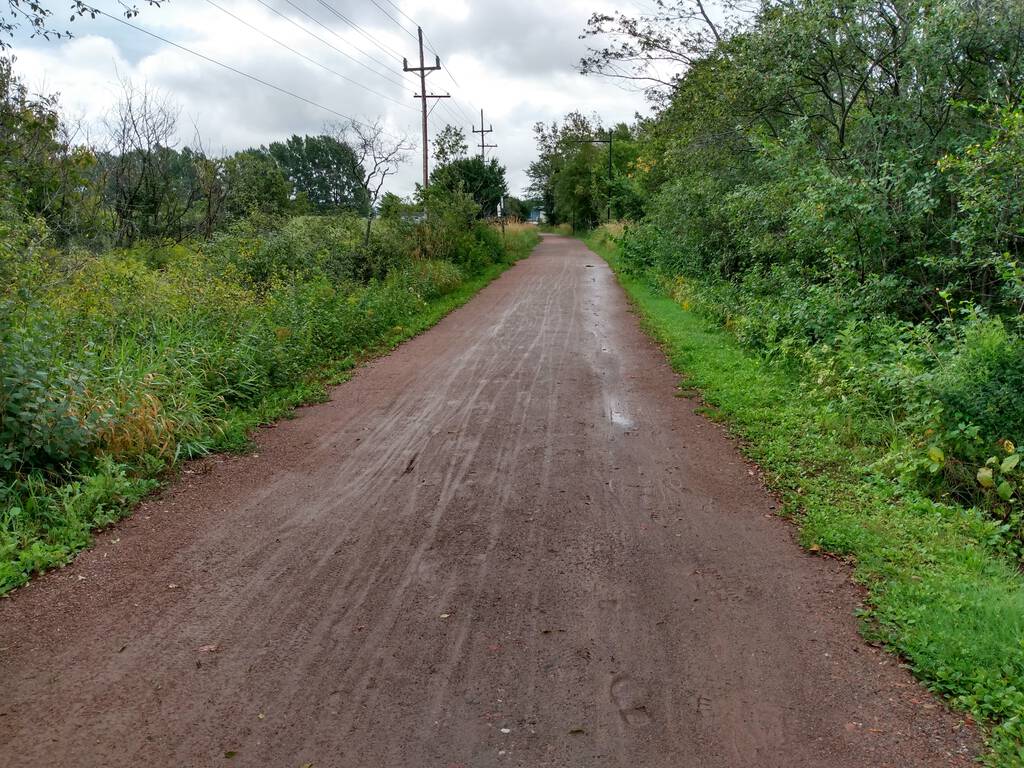
There is better census data for the trail than what gets left in the mud: the 2018 report Charlottetown’s Active Transportation Network: Downtown Connectivity & Bike/Ped Volume Information.
The study collected data at several key points along the trail for 32 hours in September 2017 and reported:
- Charlottetown Mall/Towers Mall
- ~600 Confederation Trail users north of Towers Road and ~700 to the south
- Roughly 150 trail users to/from the mall
- Over 300 pedestrians and cyclists used the Towers Road (which doesn’t lanes or sidewalks)
- Almost 250 people walked or biked between the Mall and Towers Road
- Similar numbers of pedestrians both days (except for late morning spike on Friday)
- Notably more cyclists on Saturday than Friday
- UPEI
- ~1600 Confederation Trail users at this location during the 2-day count
- Almost 300 people to/from UPEI
- 450 people used the trail to Mt. Edward Road
- Slightly more pedestrians on Friday than on Saturday (ignoring the very high pedestrian numbers around 2PM on Friday)
- Slightly more cyclists on Saturday than on Friday
- At least a couple of pedestrians during almost every 15-minute interval, whereas bikes were reported during several intervals
- Belvedere Avenue
- ~770 Confederation Trail users north of Belvedere Ave and ~880 to the south
- ~125 people accessed the Farmers Market from the Trail or Belvedere (would have been closed on Friday)
- 75-80 people walking or biking in each direction along Belvedere Avenue
- Similar numbers of pedestrians both days; 10 or more pedestrians during many of the 15-minute intervals
- Higher cyclist volumes on Friday than on Saturday
- At least 1 cyclist per interval between 6:30 AM and 7 PM
- On Saturday, very few cyclists before 9:30 AM and after 6PM
- Allen Street
- Almost 1200 Confederation Trail users north of Allen Street and ~1100 the south
- Significantly more people accessed the trail from Allen St. west vs. Allen east
- About 400 pedestrians and cyclists using Allen St. sidewalks and bike lanes
- Similar pedestrian numbers both days (ignoring the spike in pedestrian around 2PM on Friday)
- Steady use of the Trail by cyclists both days
- At least 2 cyclists during most 15-minute intervals from 10 AM to 6PM both days
- Many intervals with 3-12 cyclists
- Longworth Avenue
- 1000-1100 Confederation Trail users to the east and west of Longworth Ave
- Significantly higher pedestrian use of sidewalk on the west side of Longworth Ave than the one on the east side (600 vs. 150 south of the trail)
- Steady and consistent pedestrian activity at this location
- 10+ pedestrians during many 15-minute intervals, including a spike around 2PM Friday
- Cyclist volumes of at least 1-2 during most intervals, topping out at 11 around 1PM Friday
Linda Liukas writes about why we should teach computer science to young people:
Teaching computer science in primary school is not only about coding. It’s about developing a love of learning and offering widely-applicable, long-term ideas. A way of thinking that provides a new perspective to the world. And that’s what computer science does.
We shouldn’t teach computer science only because it’s useful, but because it’s interesting and intensely creative. Computer science blends intellectual pleasure of reason and logic with the practicality of engineering. It blends the beauty of arts with the change-the-world ethos of social sciences.
Computer science as a vector for active citizenship is a much more interesting notion than computer science as an economic development tool.
Following on from yesterday’s experimenting, here are a couple of additional visualizations of provincial road annual average daily traffic counts.
First, here are all the roads with an average daily count of 100 or fewer vehicles:

On the other end of the spectrum, here are all the roads with a daily traffic count of 2,000 or more vehicles per day:

My colleague Matthew sent me a link to this compelling GIS application that allows exploration of the provincially-maintained roads on Prince Edward Island by annual average daily traffic:
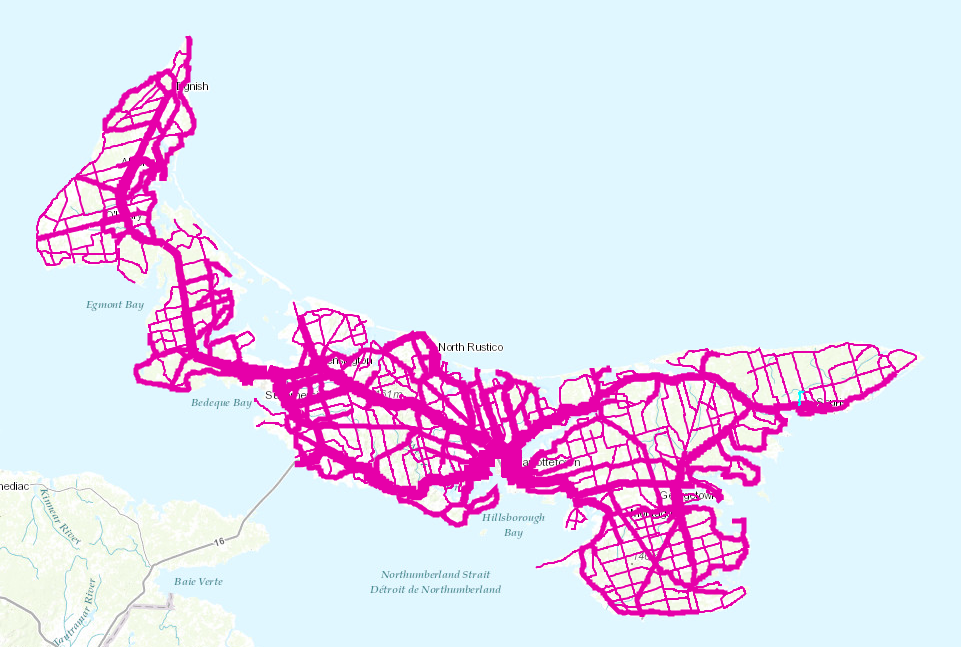
The busiest road on the Island in 2018 (the latest year for which data is presented) was the Hillsborough Bridge between Charlottetown and Stratford, with 35,053 vehicles per day:

Four roads were tied for least busy, each with an average of 42 vehicles per day.
The first two comprise this stretch of road that includes the Aberdeen Rd., the Mill Rd., and the Mickle Macum Road, near Naufrage:
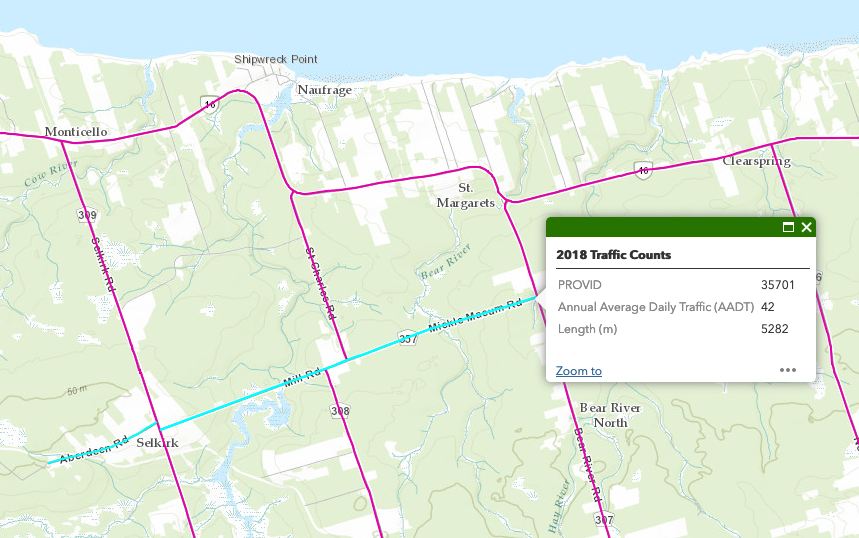
The third is the Gowan Brae Rd. near Souris:

A road that sees 42 vehicles a day is seeing under 2 cars an hour, on average. That’s a pretty sleepy road.
As you might expect, the collection of busiest provincial roads on the Island are those that run into and around Charlottetown: each of the roads highlighted in yellow on this map had a daily average of more than 12,000 vehicles:

Because the application supports exporting all of the data about the roads and the traffic counts to GeoJSON, it’s possible to cook up your own visualizations too. Here are the roads in QGIS, colour-coded by traffic count (the redder the line, the more traffic):

This visualization looks like a circulation system of the body. And, of course, that’s exactly what it is.
Kudos to the Department of Transportation, Infrastructure and Energy for releasing this data, and developing such a useful tool for exploring it.
It’s Sunday afternoon. Oliver is out with his University of PEI peers participating in a downtown scavenger hunt.
My phone rings: it’s Oliver, making a Google Duo video call.
Oliver: I am so hot!
Me: Where are you?
Oliver: I’m downtown, in the park by your old office.
Me: What about your water bottle?
Oliver: It’s empty.
Me: Okay, look in the corner, over by Richmond Centre; you will see a blue water fountain with a water bottle refiller. Go and refill your water bottle.
Oliver: Okay.
I happened to know that there was a water fountain there because I added it to OpenStreetMap two months ago.
All kinds of interoperating technology FTW.
A very helpful development at the Charlottetown Farmers’ Market this summer has been Brett Bunston’s opening of a second coffee stall, outside in the parking lot in the trailer formerly occupied by 4S Catering (and, before that, by Donkin Donuts).
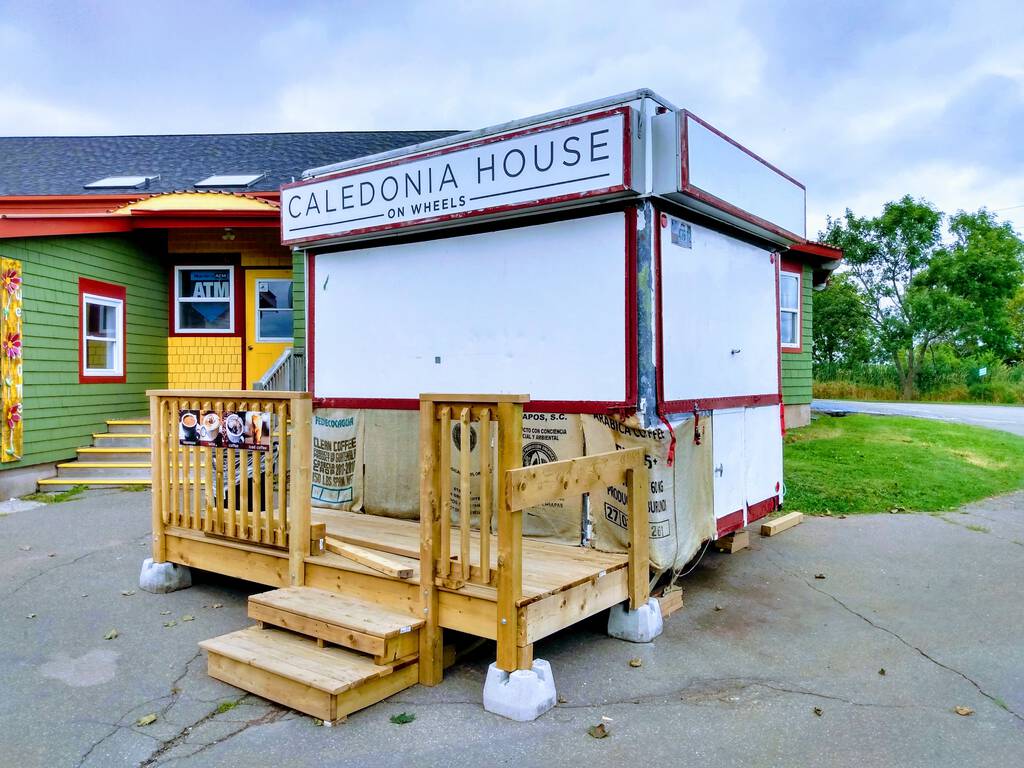
This move has significantly reduced long-coffee-line induced paralysis, especially in the busy “oh look, dear, let’s get in the wrong line for coffee and then ask lots of questions” summer months.
Now Brett is kicking it up a notch and opening the outside stall six days a week , Monday to Saturday from 6:00 a.m. to 2:00 p.m.
With the proximity to the Confederation Trail, and to UPEI (with its paucity of good coffee), this new development opens up an entirely new aspect for early-day uptown travel.
For decades Brett’s market stall was the only place to get good coffee on PEI; it’s great to see him doubling down.
Got a bicycle? Want to go for coffee some weekday? Ping me!
Thelma Phillips writes about getting the controller in her propane range rebuilt; in part:
Then I found ApplianceTimers.com, who repair mechanical and digital controls for ranges, washers, dryers and dishwashers. In addition to having an informative website, their testimonial section is helpfully organized by US state and Canadian province. There was only one testimonial from PEI at that time, and it was, of course, from someone I knew (I had taught her Sunday School a looooong time ago before I became a heathen), so I could easily confirm that ApplianceTimers.com weren’t going to take my money and run.
Thelma’s revivified blog is one of the many dividends that Crafting {:} a Life continues to pay.
There was a reference to Bike Index in this video about securing your bicycle:
Cofounded by Seth Herr and Bryan Hance in 2013, Bike Index is a 501(c)(3) nonprofit.
It is the most widely used and successful bicycle registration service in the world with over 272,000 cataloged bikes, 810 community partners and tens of thousands of daily searches.
Seth built Bike Index when he was a bike mechanic because he wanted to be able to register bikes for his customers. Bryan developed and ran a community driven bicycle recovery service (StolenBikeRegistry.com) that recovered bikes from the first week it was created in 2004.
Merging the two services Seth and Bryan created the universal bike registration service they both dreamed of — a database used and searched by individuals, bike shops, police departments and other apps. A bike registry that gives everyone the ability to register and recover bicycles.
Simple. Efficient. Effective.
I followed through and registered my own bicycle (and in the process learned that my bicycle, like many, has a serial number stamped on the bottom bracket. Who knew!
Remember the Bateman-Atkinson Bicycle Trailer Conversion? Well it’s been serving me well for over a year now, never more so than today.
Today was a complex cycling day that involved a cycle up to the Charlottetown Farmers’ Market with Oliver, and then a trip to the University of PEI for Oliver’s New Student Orientation activities (he left his bike there, and I’ll pick him up later tonight for the cycle home).
Once Oliver was in the capable hands of Blue Team, Squad Two, I dashed down University Avenue to Charlottetown Vet Clinic to get dog food, then over to MacQueen’s to pick up a kick stand for my bicycle and a water bottle holder for Oliver’s. I made a final stop at Leezen to get some soap before cycling home.
The result of all this was a full tub on top of the bike trailer, that held all of this:
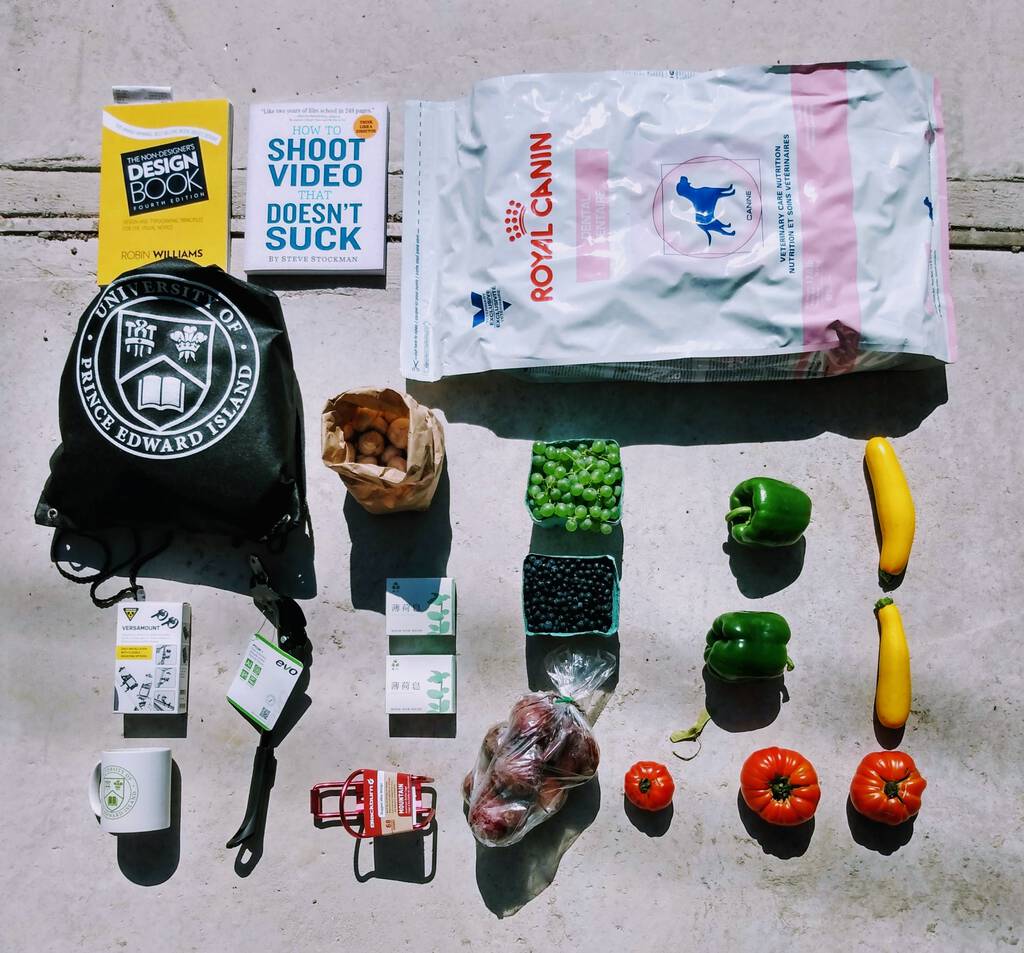
Here’s what’s in the photo, from left to right, top to bottom:
- Oliver’s two textbooks for the course ACLC 1080 - Digital Literacy, which starts next Thursday: The Non-Designer’s Design Book and How to Shoot Video that Doesn’t Suck.
- 8 kg of Royal Canin Veterinary Diet Dental Dry Dog Food from Charlottetown Vet Clinic.
- Oliver’s New Student Orientation kitbag.
- 1 lb. of mushrooms from Paul Offer.
- 1 box of seedless green grapes from Elderflower Organic Farm.
- 2 green papers and 2 zucchini from Cranbush Farms.
- Versamount water bottle holder for Oliver’s trike (which doesn’t have a universal mount), from MacQueen’s.
- Evo Pylon 1 kickstand for my bicycle, from MacQueen’s.
- Two bars of peppermint soap from Leezen.
- 1 box of wild blueberries from the, erm, blueberry sellers at the market.
- 1 Proud UPEI Parent mug.
- 1 Blackburn water bottle holder, from MacQueen’s.
- 1 bag of beets from Elderflower Organic Farm.
- 3 fresh tomatoes from Angel.
My old excuse for taking the car to the Farmers’ Market on Saturday was “well, how am I going to get everything home – I need the car for that!”
But this turns out not to be true (and we didn’t even begin to fill the basket on the back of Oliver’s bike!).
– – – – – –
I need to get better at knolling. But I’m pretty happy with the photo, which I took on my Moto G7 Play while standing on a kitchen stepladder over the contents of the bike tub spread out on our driveway. This being Charlottetown, who should cycle by than the selfsame Erin Bateman, she of the ancestral bicycle trailer.
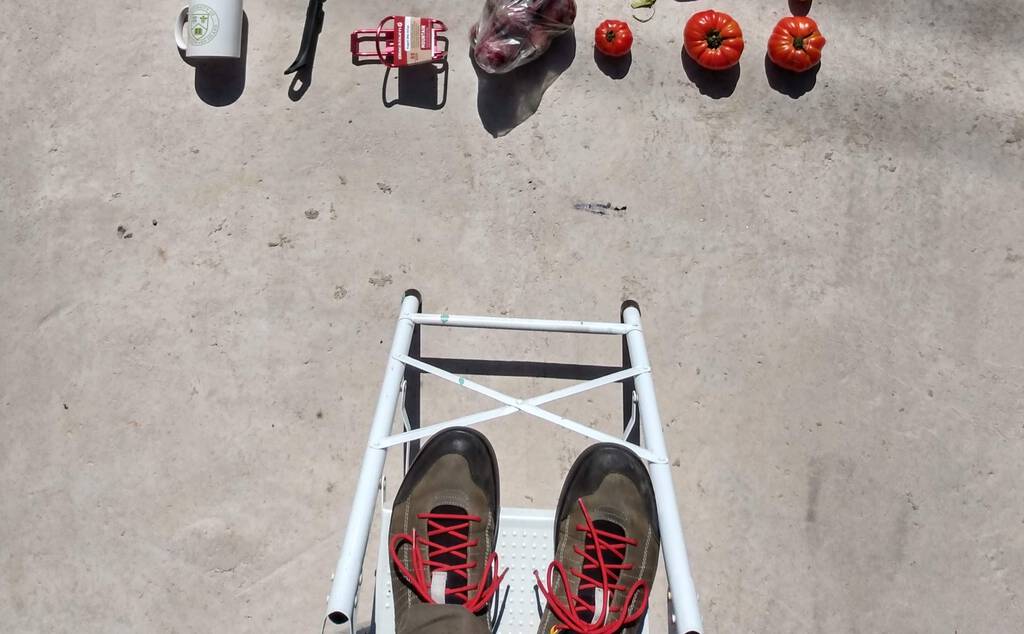

 I am
I am